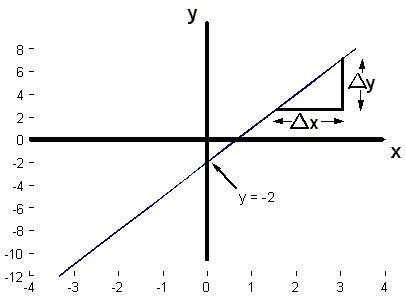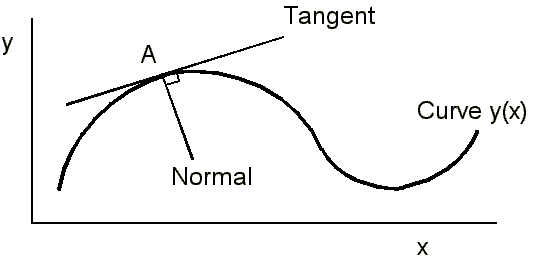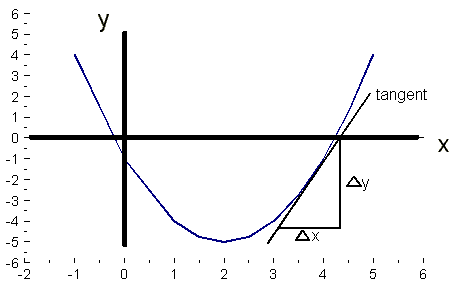
4 Basic differentiation
Differentiation is all about calculating the slope or
gradient of a curve y(x), at a given point,
x.

Notation: We use the symbol , Δ delta, to mean a
(large) change in the value of a variable. If, say, x
changes from a value of x1, to a new
value, x2, then
So the gradient of a curve y(x) can be written as:

Linear Equations

For a straight line graph of equation y(x) = mx
+ c, the gradient is given simply by the value of m.
Examples
Measuring gradients
If we don't know the equation of the straight line, we can work
out the gradient by tabulating the values of y vs. x
and plotting the graph.
Example Values of y and x are given below,
what is the gradient?
| x | -3 | -2 | -1 | 0 | 1 | 2 | 3 |
| y | -11 | -8 | -5 | -2 | 1 | 4 | 7 |
Graphical Method
(i) Plot graph

(ii) Choose any 2 points along the line (x1,y1) and (x2,y2)
(iii) Draw the triangles (as in the diagram), or just calculate
x and y.
(iv) Calculate gradient from: gradient = 
Numerical Method: choose the points we have values for,
say, (-2, -8) and (1,1). We now have:
 =
=  = 3
= 3
Since the intercept is at y = -2, we know that the eqn.
of this line must be
Finding the gradient of a general function
Linear curves are simple, but how do we find the slope of any
curve, y(x) at the point x ?

The gradient of the curve at point A is the same as that of the tangent at point A. So, all we need to do is construct the tangent and measure its gradient, Δy / Δx.
Example What is the gradient of y(x) = x2 - 4x - 1 when x = 4?
Solution Plot out the curve, then construct the tangent
when x = 4 by eye, as best you can. Measure the gradient
Δy / Δx by completing the triangle.

Graphically, we find that  = 4.
= 4.
Analytical Differentiation
Drawing tangents is a rather cumbersome method of obtaining gradients.
Is there an analytic method?
The answer is differentiation. A simplified derivation
of this is given in the handout, but we only really need to learn
the 'magic formula' (see below).
Notation: The slope, or gradient, or differential,
or derivative can be written in many equivalent ways:
 =
=  =
= 
For other variable names and functions, there is the equivalent
notation.
e.g. for s(t), we have  ,
,
for E(ν), we have 
for φ(λ), we have 
Differentiation 'magic formula' (for standard
polynomials)

To differentiate a polynomial function, multiply together the
leading factor, a, and the exponent (power),. n,
then subtract one from the exponent.
Examples
1. y = x2 ,  = 2x
= 2x
2. y = 2x3,  = 6x
= 6x
3. y = 9x27,  = 243x26
= 243x26
4. u = 3m6,  = 18m5
= 18m5
5. φ = 7λ,  = 7
= 7
6. Ψ=  ,
, 
7. p = -5q2,  = -10q
= -10q
8. y = 5,  = 0 The differential of a constant is always zero, i.e. its slope is zero, as we'd expect.
= 0 The differential of a constant is always zero, i.e. its slope is zero, as we'd expect.
 Next lecture
Next lecture